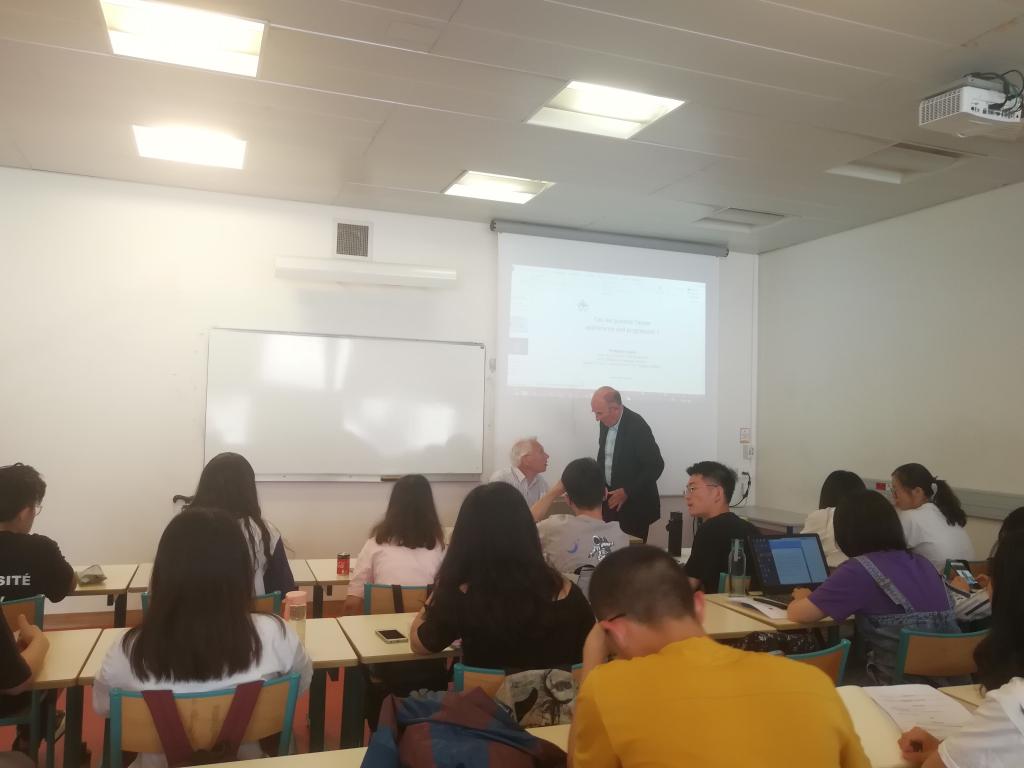探索基因殿堂,走向绝症核心
7月16号,是Human Genonics的第三节课,由Elizabeth PETIT-TEIXEIRA向我们介绍基因组测序的方法和原理。教授从测序发展历史开始,介绍了sanger测序引出今日主题-illumina。在以前的生信课上也接触过二代测序,但都只是抛出概念,这次有机会去深入学习和了解这项普遍应用的测序方法。教授从将DNA切成小片段、读段、校准等测序步骤层层讲解。一个半小时的理论讲述结束后,就进入了实战演练,通过练习题及时巩固,也学习了一下平台的使用方法。教授的讲解很细心,在练习和电脑使用时也是给每个同学单独讲解解决问题。

图1:human genomic课堂上
第一代DNA 测序技术其测试速度慢、成本高、通量低等方面的不足,也致使其不能得到大众化的应用。第二代 DNA 测序技术又称大量并行测序技术 (massive parallel sequencing,MPS)、高通量测序技术(high—throughput sequencing,HTS),以低成本、99% 以上的准确度,1次可对几百、几千个样本的几十万至几百万条 DNA 分子同时进行快速测序分析。尽管现在已经出现第三代DNA测序技术,但二代测序依然是目前测序的主要使用方法。我们生物专业的学生了解二代测序原理能加深对测序技术的理解,也有利于自己知识面的拓宽。团队中有许多生信的同学,通过这一上午的课程也能弥补校内未能深入学习测序的遗憾。
今天下午给我们讲课的是michel教授,教授年事已高,但仍精神矍铄,他娓娓道来,以癌症为话题起点,用令人印象深刻的图片,富有生活气息的表述方式给我们讲述了癌症的起源、环境和食物以及生活习惯对癌症的影响,烟草使用是造成约22%癌症死亡的原因。另外10%是由于肥胖,饮食不良,缺乏体力活动或过量饮酒。其他因素包括某些感染,接触电离辐射和环境污染物。在发展中国家,15%的癌症是由于幽门螺杆菌,乙型肝炎,丙型肝炎,人乳头瘤病毒感染,巴尔病毒和人类免疫缺陷病毒(HIV)等感染引起的。这些因素至少部分地通过改变细胞的基因起作用。许多癌症可以通过不吸烟,保持健康的体重,不喝太多酒,吃大量的蔬菜,水果和全谷物,接种某些疫苗,不吃过多的加工红肉以及避免过多的阳光照射来预防。让我们对于癌症的理解进一步加深。

图2:Alain和Michel教授交流
教授向我们介绍了表观遗传的作用,其通过控制基因的表达,让每个个体有所不同,而且告诉我们表观遗传的变化可以遗传到下一代。教授具体讲述了影响衰老的因素。他提到,健康的饮食习惯和生活方式是长寿的关键,营养成分可以影响基因组、表观遗传和微生物群。甲基化程度可以预测将来的疾病风险和死亡率。除此之外,教授还给我们介绍了表观遗传的作用,其通过控制基因的表达,让每个个体有所不同,而且告诉我们表观遗传的变化可以遗传到下一代。教授具体讲述了影响衰老的因素。他提到,健康的饮食习惯和生活方式是长寿的关键,营养成分可以影响基因组、表观遗传和微生物群。甲基化程度可以预测将来的疾病风险和死亡率。
除了讲述知识,教授还和我们分享了他自己的生活见闻:从他对中国,对中国食物的印象以及中国文化对他的影响,到有趣的科学史、他和沃森大佬的合照、巴斯德所的研究方向。
通过几天的共同学习,团队气氛越来越融洽,学习效率越来越高,课堂氛围也越来越活泼。其中一点一滴的变化都承载着我们每个人的努力,希望大家能够在此次巴黎之旅中都能够满载收获,有所成长!
Exploring Gene Palace and Towards the Core of Diseases
July 16, the third lesson of Human Genonics. Elizabeth PETIT-TEIXEIRA introduces us to the methods and principles of genome sequencing. Starting with the history of sequencing, the professor introduced Sanger sequencing to illumina, the topic of today. In the past, I have been exposed to second-generation sequencing in Shengxin class, but all of them just throw out the concept. This is an opportunity to learn more about this commonly used sequencing method. Professor from the DNA cut into small fragments, reading segments, calibration and other sequencing steps to explain layer by layer. After an hour and a half of theoretical narration, we entered the actual combat drill. We consolidated the exercises in time and learned how to use the platform. Professor's explanation is very careful, in practice and computer use is also to give each student a separate explanation to solve the problem.

Figure 1: Human genomic class
The first generation of DNA sequencing technology has some shortcomings, such as slow testing speed, high cost and low throughput, which also makes it unable to be widely used. Second-generation DNA sequencing technology, also known as massive parallel sequencing (MPS), high-throughput sequencing (HTS), can rapidly sequence hundreds of thousands to millions of DNA molecules in hundreds of thousands of samples at a time with low cost and 99% accuracy. Despite the emergence of the third generation DNA sequencing technology, the second generation sequencing is still the main method of sequencing. Our students majoring in biology understand the principle of second generation sequencing, which can deepen their understanding of sequencing technology, and also help broaden their knowledge. There are many students in the team who believe that this morning's course can also make up for the regret that the school has not been able to learn sequencing in depth.
This afternoon, Professor Michel gave us a lecture. Professor Michel is very old, but still energetic. He started with cancer and told us about the origin of cancer, the environment, food and the impact of living habits on cancer with impressive pictures.Tobacco use is responsible for about 22% of cancer deaths. Another 10% are due to obesity, poor diet, lack of physical activity or excessive drinking. Other factors include certain infections, exposure to ionizing radiation and environmental pollutants. In developing countries, 15% of cancers are caused by Helicobacter pylori, hepatitis B, hepatitis C, human papillomavirus, Barr virus and human immunodeficiency virus (HIV). These factors work, at least in part, by altering the genes of cells. Many cancers can be prevented by not smoking, maintaining a healthy weight, not drinking too much alcohol, eating too much vegetables, fruits and whole grains, vaccinating against certain vaccines, not eating too much processed red meat and avoiding too much sunlight. Let's deepen our understanding of cancer.

Figure 2: Professor Alain and Professor Michel
The professor also introduced us to the role of epigenetics, which makes each individual different by controlling gene expression, and tells us that epigenetic changes can be inherited to the next generation. The professor gave a detailed account of the factors affecting aging. He mentioned that healthy eating habits and lifestyles are key to longevity, and nutrients can affect genomes, epigenetics and microbial populations. The degree of methylation can predict future disease risk and mortality.
In addition to his knowledge, the professor shared with us his own life experiences: from his impression of China, Chinese food and the influence of Chinese culture on him, to the interesting history of science, his photograph with Watson, and Pasteur's research direction.
Through several days of joint learning, the team atmosphere is more and more harmonious, learning efficiency is higher and higher, and the classroom atmosphere is more and more lively. Every one of these changes bears the efforts of all of us. I hope you will be able to fully harvest and grow in this trip to Paris.